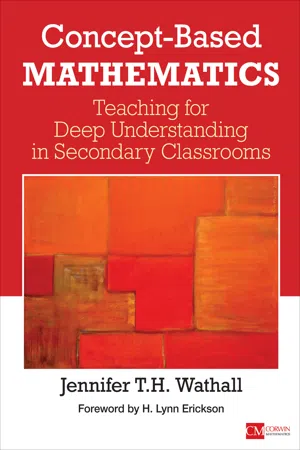
Concept-Based Mathematics
Teaching for Deep Understanding in Secondary Classrooms
- 296 pages
- English
- ePUB (mobile friendly)
- Available on iOS & Android
About This Book
Give math students the connections between what they learn and how they do math—and suddenly math makes sense If your secondary-school students are fearful of or frustrated bymath, it's time for a new approach. When you teach concepts rather than rote processes, you show students math's essential elegance, as well as its practicality—and help them discover their own natural mathematical abilities. This book is a road map to retooling how you teach math in a deep, clear, and meaningful way —through a conceptual lens—helping students achieve higher-order thinking skills. Jennifer Wathall shows you how to plan units, engage students, assess understanding, incorporate technology, and even guides you through an ideal concept-based classroom.
- Practical tools include:
- Examples from arithmetic to calculus
- Inquiry tasks, unit planners, templates, and activities
- Sample assessments with examples of student work
- Vignettes from international educators
- A dedicated companion website with additional resources, including a study guide, templates, exemplars, discussion questions, and other professional development activities.
Everyone has the power to understand math. By extending Erickson and Lanning's work on Concept-Based Curriculum and Instruction specifically to math, this book helps students achieve the deep understanding and skills called for by global standards and be prepared for the 21st century workplace. "Jennifer Wathall's book is one of the most forward thinking mathematics resources on the market. While highlighting the essential tenets of Concept-Based Curriculum design, her accessible explanations and clear examples show how to move students to deeper conceptual understandings. This book ignites the mathematical mind!" — Lois A. Lanning, Author of Designing Concept-based Curriculum for English-Language Arts, K-12 "Wathall is a master at covering all the bases here; this book is bursting with engaging assessment examples, discussion questions, research, and resources that apply specifically to mathematical topics. Any math teacher or coach would be hard-pressed to read it and not come away with scores of ideas, assessments, and lessons that she could use instantly in the classroom. As an IB Workshop Leader and instructional coach, I want this book handy on a nearby shelf for regular referral – it?s a boon to any educator who wants to bring math to life for students." — Alexis Wiggins, Instructional Coach, IB Workshop Leader and Consultant
Frequently asked questions
Information
Part I What Is Concept-Based Curriculum and Instruction in Mathematics? Research and Theory
Chapter 1 Why Is It Important for My Students to Learn Conceptually?
Why Do We Need to Develop Curriculum and Instruction to Include the Conceptual Level?
- Critical thinking and problem solving,
- Collaboration (the ability to work in a team),
- Communication (oral and written), and
- The ability to adapt to a changing environment.
We owe our students more than asking them to memorize hundreds of procedures. Allowing them the joy of discovering and using mathematics for themselves, at whichever level they are able, is surely a more engaging, interesting and mind-expanding way of learning. Those “A-ha” moments that you see on their faces; that’s why we are teachers.David Sanda, Head of Mathematics Chinese International School, Hong Kong
The Structure of Knowledge and the Structure of Process

The Structure of Knowledge and the Structure of Process for Functions



Table of contents
- Cover
- Acknowledgements
- Half Title
- Title Page
- Copyright Page
- Contents
- Illustration List
- Illustration List
- Illustration List
- Illustration List
- Illustration List
- Illustration List
- Illustration List
- Illustration List
- Illustration List
- Foreword
- Preface
- Acknowledgments
- About the Author
- Author’s Note
- Acknowledgements
- Part I What Is Concept-Based Curriculum and Instruction in Mathematics? Research and Theory
- Chapter 1 Why Is It Important for My Students to Learn Conceptually?
- Chapter 2 What Are the Levels of the Structures of Knowledge and Process for Mathematics?
- Part II How to Craft Generalizations and Plan Units of Work to Ensure Deep Conceptual Understanding
- Chapter 3 What Are Generalizations in Mathematics?
- Chapter 4 How Do I Plan Units of Work for a Concept-Based Curriculum?
- Part III How Do We Engage Students Through Instructional Practice? Strategies to Engage and Assess
- Chapter 5 How Do I Captivate Students? Eight Strategies for Engaging the Hearts and Minds of Students
- Chapter 6 How Do I Know My Students Understand the Concepts? Assessment Strategies
- Chapter 7 How Do I Integrate Technology to Foster Conceptual Understanding?
- Chapter 8 What Do Ideal Concept-Based Mathematics Classrooms Look Like?
- Glossary
- Teaching for Deep Understanding in Secondary Schools Book Study
- References
- Index
- Publisher Note